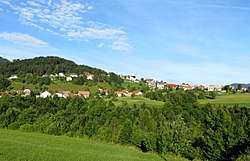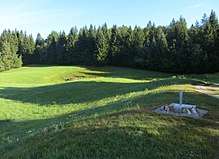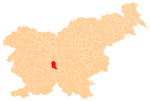Golo, Ig
Golo (pronounced [ˈɡɔːlɔ], German: Golu[2]) is a village in the hills south of Ig in central Slovenia. The entire Municipality of Ig is part of the traditional region of Inner Carniola and is now included in the Central Slovenia Statistical Region.[3]
Golo | |
|---|---|
 | |
 Golo Location in Slovenia | |
| Coordinates: 45°54′31.57″N 14°32′49.85″E | |
| Country | |
| Traditional region | Inner Carniola |
| Statistical region | Central Slovenia |
| Municipality | Ig |
| Area | |
| • Total | 11.93 km2 (4.61 sq mi) |
| Elevation | 680.6 m (2,232.9 ft) |
| Population (2002) | |
| • Total | 334 |
| [1] | |
Geography
Golo is a clustered village with two settlement centers: the hamlets of Gorenje Golo (German: Obergolu)[4] and Dolenje Golo (German: Untergolu).[4] It lies along the road from Ig to Visoko northeast of Mount Mokrec (elevation: 1,059 meters or 3,474 feet).[5] Golec Hill (elevation: 766 meters or 2,513 feet) rises to the southwest.
History
Early settlement in Golo is attested by archaeological finds, including Hallstatt culture artifacts and a Roman-era fortification near the site of the church.[5][6] A castle known as Nad Gačo stood above the rectory.[5][6] A part-time school was established in Golo in 1874, and regular schooling was started in 1908. Until the school building was built in 1925, classes were held in the rectory. During the Second World War, Italian forces burned the village on March 19, 1942. Later the same year, on July 23, they killed 12 hostages at Gmajna below Golec Hill.[5]
Mass grave

Golo is the site of a mass grave from the period immediately after the Second World War. The Golo Mass Grave (Slovene: Grobišče Golo) is located in a sinkhole south of the settlement in the hamlet of Stara Žaga. It contains the remains of a large number of Home Guard prisoners of war that were transported by truck from the prison in Šentvid and murdered here on July 26, 1945.[7]
Church

The local parish church, built outside the settlement to the northeast, is dedicated to Saint Margaret (Slovene: sveta Marjeta) and belongs to the Roman Catholic Archdiocese of Ljubljana. It is a Baroque building, dating to the 18th century. A prehistoric Iron Age settlement has also been identified at the site around the church.[8] The structure at the site was first mentioned in 1631; it was made a quasi-parish in 1787 and was elevated to a parish in 1877. The current church dates to the beginning of the 19th century. Its altar and pulpit date from the second half of the 18th century and were transferred to the church from the monastery church in Kostanjevica na Krki. The church was burned by Italian forces in March 1942 and was renovated after the war.[5]
Notable people
Notable people that were born or lived in Golo include:
- Lovro Mencinger (1835–1903), orchardist. He lived in Golo from 1866 to 1891 and was the first to describe the glory optical phenomenon there.[5][9]
References
- Statistical Office of the Republic of Slovenia
- Deschmann, Carl. 1866. Zusammenstellung der bisher in Krain gemachten Höhenmessungen. Mittheilungen des Museal-Vereins für Krain, pp. 1–76. Ljubljana: Musealvereins, p. 29.
- Ig municipal site
- Leksikon občin kraljestev in dežel zastopanih v državnem zboru, vol. 6: Kranjsko. 1906. Vienna: C. Kr. Dvorna in Državna Tiskarna, p. 116.
- Savnik, Roman, ed. 1971. Krajevni leksikon Slovenije, vol. 2. Ljubljana: Državna založba Slovenije, p. 409.
- Požgane vasi. 1942. Glas naroda 50(163): 2.
- Ferenc, Mitja (December 2009). "Grobišče Golo". Geopedia (in Slovenian). Ljubljana: Služba za vojna grobišča, Ministrstvo za delo, družino in socialne zadeve. Retrieved April 12, 2020.
- Slovenian Ministry of Culture register of national heritage reference number ešd 1812
- Pirjevec, Avgust. 1933. Mencinger, Lovro (1835–1903). In: Franc Ksaver Lukman et al. (eds.), Slovenski biografski leksikon, vol. 5, Maas–Mrkun. Ljubljana: Zadružna gospodarska banka.
